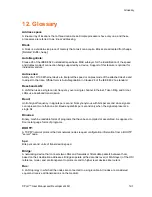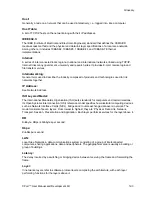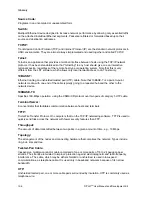
Glossary
12. Glossary
Address space
A linear array of locations that a thread can access. Simple processors have only one, and these
processors are referred to as `linear' addressing.
Block
A block is a variable-size piece of memory that a task can acquire. Blocks are allocated from heaps.
[Related: Buffer, heap]
Auto-Negotiate:
Clause 28 of the IEEE 802.3u standard specifies a MAC sublayer for the identification of the speed
and duplex mode of connection being supported by a device. Support of this feature is optional for
individual vendors.
Auto-sense:
Ability of a 10/100 Ethernet device to interpret the speed or duplex mode of the attached device and
to adjust to that rate. Official term is Auto-Negotiation in Clause 28 of the IEEE 802.3u standard.
Baseband LAN:
A LAN that uses a single carrier frequency over a single channel. Ethernet, Token Ring and Arcnet
LANs use baseband transmission.
Baud:
Unit of signal frequency in signals per second. Not synonymous with bits per second since signals
can represent more than one bit. Baud equals bits per second only when the signal represents a
single bit.
Binaries:
Binary, machine readable forms of programs that have been compiled or assembled. As opposed to
Source language forms of programs.
BOOTP:
A TCP/IP network protocol that lets network nodes request configuration information from a BOOTP
"server" node.
bps:
Bits per second, units of transmission speed.
Bridge:
A networking device that connects two LANs and forwards or filters data packets between them,
based on their destination addresses. Bridges operate at the data link level (or MAC-layer) of the OSI
reference model, and are transparent to protocols and to higher level devices like routers.
Bus:
A LAN topology in which all the nodes are connected to a single cable. All nodes are considered
equal and receive all transmissions on the medium.
XPort™ User Manual and Development Kit
12-1







































